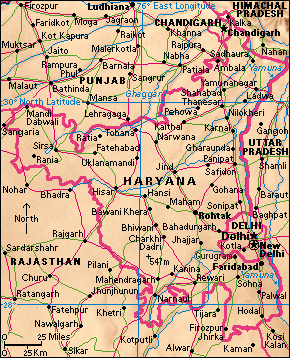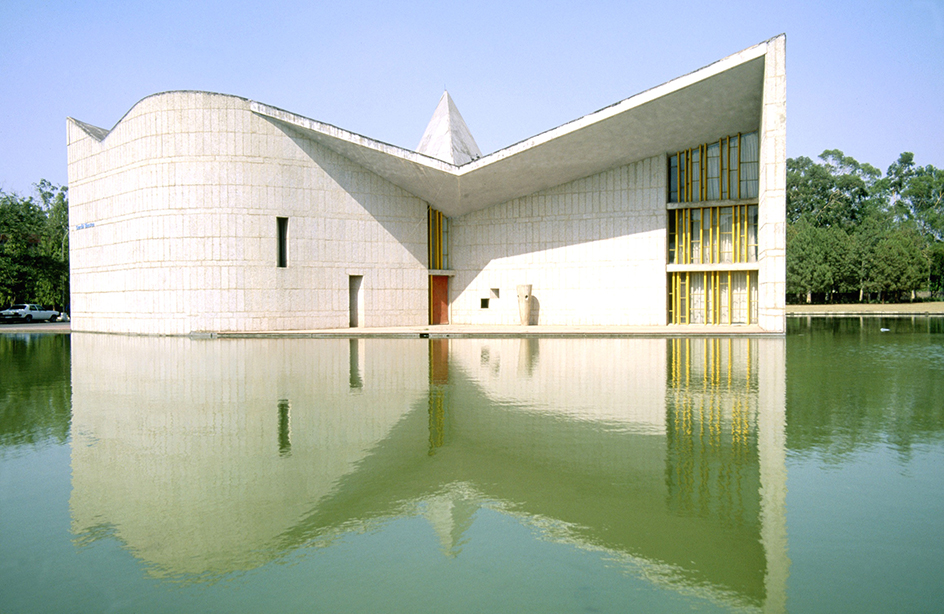Haryana (pop. 25,351,462) is a state in northern India. In the past, the area has been the site of several crucial battles. The great battle between the Kauravas and Pandavas—recorded in the Mahabharata, an ancient Hindu epic—occurred at Kurukshetra. Haryana is now an important agricultural region close to New Delhi, the capital city of India.
People and government.
About 90 percent of the population are Hindus, and live mainly in rural areas. Chandigarh, which is a separate territory, serves as the capital of both Haryana and Punjab. There are also several large market towns. The main language spoken is Hindi, but Urdu and Punjabi are also widely spoken.
The president of India appoints a governor of the state for a five-year term. A council of ministers drawn from the legislative assembly aids the governor. Haryana has 90 seats in the legislative assembly. Haryana has 10 elected members in the Lok Sabha (lower house) and 5 nominated representatives in the Rajya Sabha (upper house) of the Indian national parliament. At the district level, the chief administrative officer is called the collector. The panchayat raj (village council rule) includes all 7,000 villages in Haryana.

Economy.
Agriculture is the main economic activity and the state government has invested heavily in farming. It has increased the irrigation network and promoted modern crop technology. Now crops cover over 80 percent of the total area, and grain production has increased rapidly. Gram (lentils), mustard, and wheat are the main winter crops. Cotton, corn, rice, and sugar cane are the main summer crops. Cotton and sugar-processing are important industries. The state also produces high-quality dairy cattle.
The state’s industries produce automobiles and auto parts, electronic components, processed foods, textiles, and many other products.
The main towns and cities of the region are on the Grand Trunk Road, the great highway from Lahore to Kolkata. The state has good road and rail services.

Land and climate.
Haryana is roughly triangular in shape. It has borders with Rajasthan to the west, Punjab to the northwest, Himachal Pradesh to the north, and Uttarakhand, Uttar Pradesh, and Delhi to the east. Except for a small northern portion of the state which lies in the Siwaliks, Haryana consists of level plain. The Yamuna (or Jumna) River forms the boundary of Haryana. The waters of the Yamuna feed the irrigation network.
The average daily minimum temperature is 45 °F (7 °C) in January and 79 °F (26 °C) in June. The maximum is 68 °F (20 °C) in January and 102 °F (39 °C) in June. Annual rainfall in Chandigarh is 43 inches (109 centimeters), most of which falls between June and October.
History.
The earliest settlements that archaeologists have found in Haryana date to the late Harappan period (around 1700 B.C.). These are followed by settlements where archaeologists found ochre color pottery. The sites are thus known as part of the Ochre Color Culture. A later important group to live in the region herded cattle and other animals and were farmers. Archaeologists know their settlements from a particular kind of pottery they used known as Painted Gray Ware.
The region experienced many invasions from the northwest, by the Greeks, the Scythians, the Kushanas, the Huns, the Turks and Afghans, and eventually the Mughals. Some of these ruled the area, particularly the Mughals. In 1857, Haryana leaders played a large part in a major revolt against British rule.
The state of Haryana was formed in 1966 from Hindi-speaking parts of the Indian state of Punjab.
